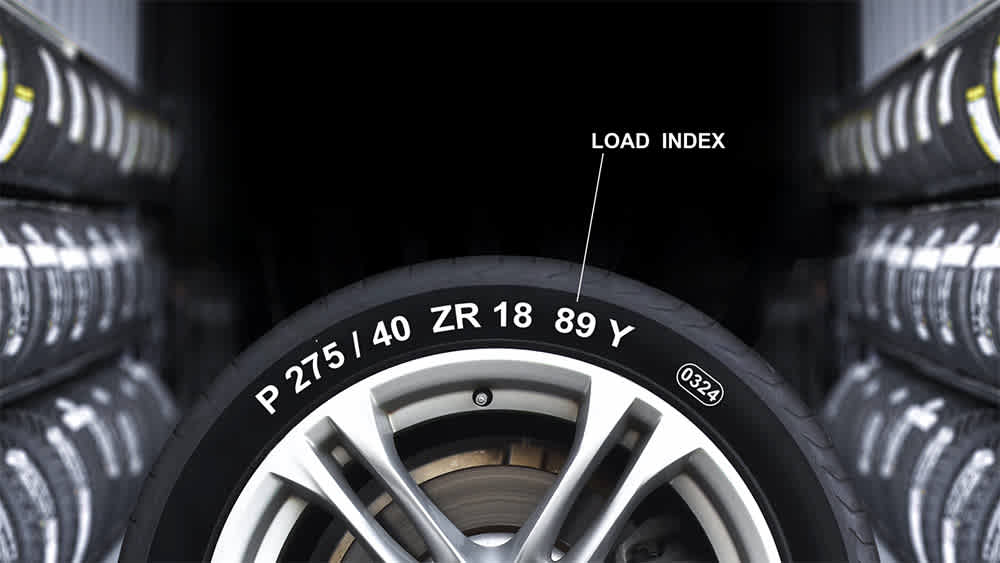Tire Maintenance & Safety
Free shipping
Best price guarantee
Special pricing
Financing with Resolve
Easy returns

Every tire on your vehicle carries a specific amount of weight while enduring various stresses during daily driving. This capacity to handle weight and stress determines whether your tires can safely support your car, truck, or SUV along with its passengers and cargo.
The relationship between tire specifications and vehicle safety extends beyond simple weight measurements. Modern tires incorporate complex engineering that balances load-carrying ability with performance characteristics like traction, handling, and durability.
Understanding how much weight your tires can safely support helps prevent dangerous situations like blowouts and ensures optimal vehicle performance. This knowledge becomes especially important when loading your vehicle for trips, towing trailers, or carrying heavy cargo.
What Is Tire Workload?
Tire workload represents the total demand placed on a tire during operation — encompassing the vehicle's weight, passenger load, cargo, and the dynamic forces created during acceleration, braking, and cornering. This measurement goes beyond static weight to include all the stresses a tire experiences while rolling down the road. Think of it as the complete job description for your tires: supporting weight, maintaining traction, absorbing road impacts, and transferring steering inputs to the pavement.
The concept emerged from the commercial trucking and heavy equipment industries, where engineers needed precise calculations to ensure tire safety under extreme conditions. For passenger vehicles and light trucks, tire workload translates into practical specifications that help drivers select appropriate tires. These specifications account for factors like weight distribution, speed capabilities, and the tire's internal construction — all working together to determine how much "work" a tire can safely perform.
Understanding tire workload involves recognizing three key components:
- Static load capacity: The maximum weight a tire can support when the vehicle is stationary
- Dynamic stress factors: Additional forces created by vehicle movement, including centrifugal force during turns and weight transfer during braking
- Safety margins: Built-in reserves that ensure tires can handle unexpected situations without failure
Your vehicle manufacturer calculates the appropriate tire workload based on the vehicle's design weight, intended use, and performance requirements. This calculation results in specific tire specifications that appear on your vehicle's door placard and in the owner's manual — numbers and letters that indicate exactly what kind of tires your vehicle needs to operate safely.
How Is Tire Workload Measured?

Load Index Numbers
To determine a tire's capacity for carrying weight, load index numbers are essential. These numbers, prominently displayed on the tire's sidewall after the tire size, specify the maximum weight the tire can support when properly inflated. For example, a tire marked with a load index of 91 supports up to 1,356 pounds. This system provides a clear guideline for selecting tires that align with your vehicle’s weight requirements, ensuring that the tires can handle the demands of everyday driving.
Choosing tires with the appropriate load index is crucial for maintaining safety and performance. The load index provides a direct reference to the tire’s load-carrying ability, making it easier for drivers to match their tires to the vehicle's specifications. Always select tires with a load index that meets or surpasses the manufacturer’s recommendations to guarantee your vehicle remains safe and efficient.
Load Range Letters
Load range letters, another vital aspect of measuring tire workload, indicate the tire's strength and capacity through a letter system from A to G. Each letter correlates with a specific ply rating, reflecting the tire's construction quality and ability to support heavier loads. Tires with higher load range letters possess enhanced strength, making them suitable for vehicles that carry more weight or operate under rigorous conditions.
The ply rating associated with these letters gives insight into the tire's internal makeup. Tires labeled with a higher load range feature stronger materials and more layers, enhancing their durability. Both the load index and load range work together to ensure the tire's suitability for your vehicle’s demands, providing peace of mind that your tires can handle the rigors of the road.
Why Is Tire Workload Important for Safety?

Understanding tire workload goes beyond technical specifications—it plays a vital role in ensuring road safety. Tires that exceed their weight limits can generate excessive heat, compromising their structural integrity. This heat buildup may cause tire failure, which poses serious risks, particularly at higher speeds. Keeping tires within their workload limits is essential for maintaining vehicle stability and safety.
Properly aligned tire workload contributes to effective vehicle handling and braking. Overloaded tires struggle to maintain grip, impacting the vehicle's ability to steer and stop accurately. This reduction in performance can lead to increased accident risk, especially in sudden maneuvers. Selecting tires with the appropriate load capacity ensures they support the vehicle's weight adequately, providing consistent performance under various driving conditions.
Neglecting tire workload specifications can lead to uneven tread wear and potential blowouts. Operating tires beyond their intended capacity accelerates their degradation, reducing tread life and grip. This not only shortens the tire’s lifespan but also heightens the risk of unexpected tire failure. Consistent maintenance practices—such as regular tire pressure checks and inspections for signs of wear—help ensure that tires can manage their workload securely and perform reliably.
Understanding Tire Load Index and Load Capacity
Reading the Numbers
The load index provides a numerical representation of a tire’s ability to bear weight, ranging from 70 to 150. Each number corresponds to a specific weight capacity in pounds, indicating how much load the tire can safely support. This system aids drivers in selecting tires that align with their vehicle’s intended use and design specifications. When choosing new tires, it’s essential to ensure the load index aligns with or surpasses what’s specified in your vehicle’s manual. This alignment helps prevent excessive strain on tires, promoting longevity and maintaining vehicle balance.
Opting for a tire with a higher load index number can offer additional assurance when regularly transporting heavy items or towing. This choice supports tire durability under demanding conditions, ensuring the vehicle responds predictably and effectively. By adhering to these guidelines, drivers can optimize the tire’s performance and maintain fuel efficiency, all while ensuring the vehicle behaves as expected.
Calculating Total Vehicle Capacity
To accurately determine your vehicle's carrying capacity, begin with the tire's designated load capacity and multiply it by four. This calculation provides a comprehensive understanding of the total weight your vehicle can handle. It's crucial to incorporate the combined weight of passengers, luggage, and any extra gear into this calculation for an accurate assessment.
The Gross Vehicle Weight Rating (GVWR) must be respected as the maximum threshold for safe vehicle operation. This rating encompasses the vehicle’s full weight capacity, including all occupants and cargo. Staying within the GVWR ensures that the vehicle operates safely and efficiently, protecting tires and other components from undue stress. Adhering to these parameters not only promotes safety but also supports the vehicle's durability and performance over time.
What's the Difference Between Load Index and Load Range?
The load index and load range each provide insight into a tire's weight-bearing capabilities but do so in unique ways. The load index delivers a numerical value that specifies the maximum load a tire can handle when properly inflated. Displayed on the tire’s sidewall, this number acts as a straightforward guide for matching tires to the vehicle’s weight requirements.
In contrast, the load range employs letters to describe a tire’s structural strength and endurance. This letter-based system reflects the tire's ply construction, signifying the robustness of its build. Tires with higher load range letters are engineered with enhanced materials, designed to withstand more demanding uses and heavier weights. These designations together ensure that tires meet the necessary demands under various conditions, supporting safe and reliable vehicle operation.
Light truck tires often carry dual load index numbers—one for single and another for dual wheel setups. This dual rating acknowledges the diverse applications of light trucks, which may need different load capacities based on their wheel configurations. It enables drivers to optimize tire performance according to their vehicle's specific setup, ensuring adaptability and safety across driving conditions. Understanding how load index and load range interact allows drivers to make informed choices, promoting tire longevity and vehicle safety.
How Tire Inflation Pressure Affects Workload
Tire inflation pressure plays a pivotal role in a tire’s ability to perform its duties effectively. When tires are inflated to their specified pressure, they retain their designed form, providing the needed support for the vehicle’s weight and ensuring optimal road contact. This precise inflation enhances the vehicle's handling and fuel consumption, allowing the tires to operate efficiently and safely.
Improperly inflated tires, particularly those underinflated, face several challenges. They tend to sag under the vehicle's load, which can lead to increased rolling resistance and irregular wear. This sagging can also cause the tire to overheat, which is a major contributor to tire degradation and potential failure. Furthermore, underinflated tires may compromise the vehicle's maneuverability, affecting its response in critical situations.
Checking tire pressure on a regular basis is an essential part of vehicle maintenance. Ideally, inspections should occur monthly and before embarking on extended journeys. Use a dependable gauge to measure pressure when the tires are cool, as driving heats the tires and can skew readings. The pressure should match the manufacturer’s specifications, which are usually found in the vehicle manual or on the door placard. This attention to proper inflation supports the tire's workload and contributes to overall vehicle reliability and safety.
Special Considerations for Different Vehicle Types
Passenger Vehicles
Passenger cars, like sedans and hatchbacks, typically utilize tires with load capacities sufficient for everyday driving needs. The load index for these vehicles generally reflects their lighter weight and less demanding usage conditions. Most standard tires for passenger vehicles come with 4-ply ratings or fewer, which adequately support their intended functions. Ensuring that new tires match or exceed the vehicle's original specifications is crucial to preserving its intended ride quality and safety features.
Light Trucks and SUVs
Light trucks and SUVs require tires designed for heavier loads and more robust usage. These vehicles often need tires with enhanced structural integrity to manage their increased weight and towing capabilities. Tires for light trucks and SUVs frequently feature 6-ply ratings or higher, offering the necessary durability for both on-road and off-road conditions. When choosing tires for these vehicles, it’s important to evaluate the vehicle’s specific demands, such as towing and hauling capacities, to ensure that the tires can effectively support these activities without compromising safety.
Electric Vehicles
Electric vehicles (EVs) demand specialized tires to accommodate the substantial weight of their battery packs. Tires with High Load (HL) ratings are engineered to endure the additional stress placed by EVs, ensuring optimal performance and range. The construction of these tires includes reinforced materials that support both the vehicle’s weight and its unique performance characteristics. Selecting the appropriate HL-rated tires is essential for maintaining the vehicle’s range capabilities and ensuring its safety standards are met.
How to Choose the Right Tire Workload for Your Vehicle

Choosing the right tire workload involves identifying the specific requirements of your vehicle. Start by examining the information provided in the vehicle's manual or on the tire information label located on the driver's door jamb. This will guide you in selecting tires that are compatible with your vehicle's design specifications and performance needs.
Evaluate the typical driving conditions and the type of loads your vehicle frequently handles. If you often drive on rough terrain or carry heavy cargo, you’ll need tires with enhanced strength and durability. Tires with a higher load index are suitable for these conditions, ensuring that your vehicle's tires can withstand the additional demands placed upon them without compromising safety.
Utilize a detailed tire buying guide to compare different tire options based on your vehicle's specific needs. These resources offer insights into tire features and specifications, helping you select tires that can support your driving habits effectively. Avoid installing tires with load ratings lower than what your vehicle requires to prevent potential safety hazards and ensure optimal tire performance.
Consider any additional equipment or modifications that might alter your vehicle's weight. Accessories like roof racks or custom installations can add significant weight, affecting the tire's workload. Choosing tires with a higher load range can provide the extra support needed to accommodate these changes, ensuring your vehicle remains stable and performs reliably. By addressing these factors, you ensure your vehicle's tires are well-suited for its intended use.
Understanding tire workload empowers you to make informed decisions that keep your vehicle safe and performing at its best. By selecting tires with the proper load index and maintaining correct inflation pressure, you protect your investment while ensuring reliable transportation for years to come. When you're ready to find tires that match your vehicle's specific workload requirements, we make it easy to shop for tires online and find the best deals with our comprehensive selection and expert guidance.
Ready to find the perfect tires?
Search By